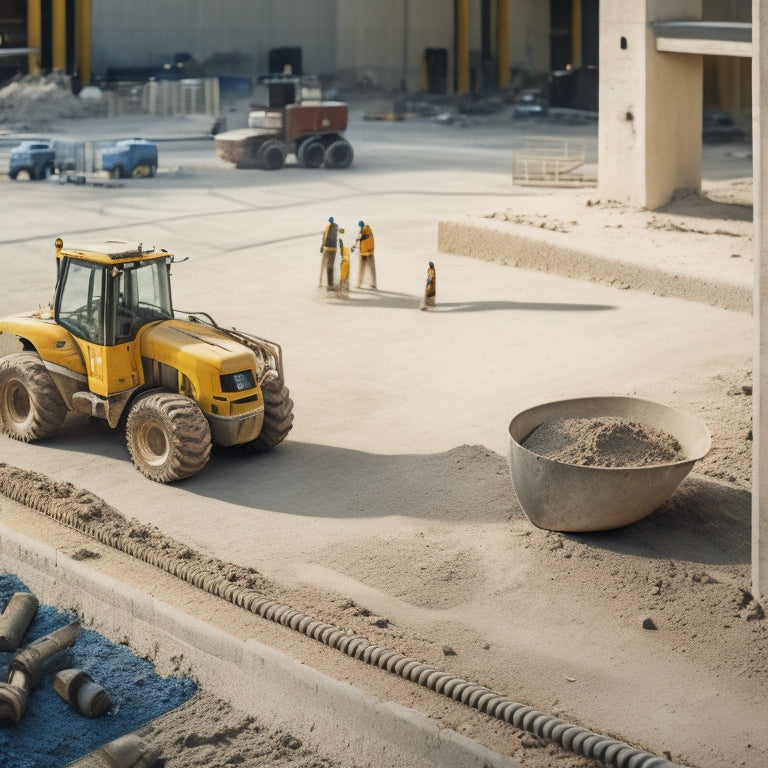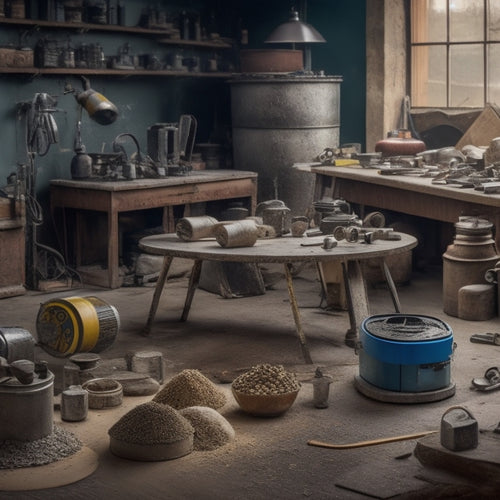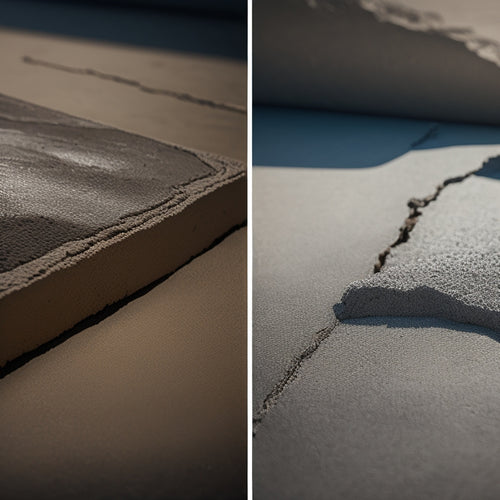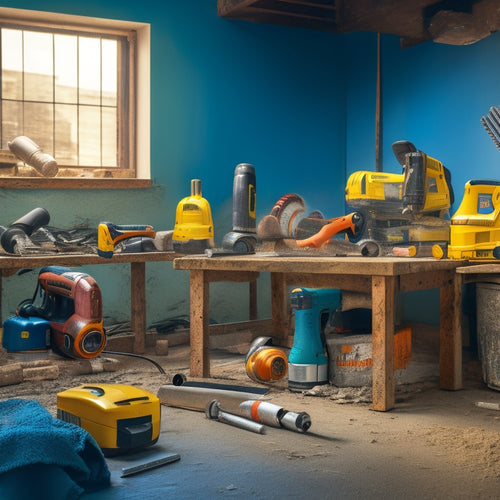
5 Must-Have Tools for Premixed Concrete Projects
Share
When tackling a premixed concrete project, you'll need the right tools to get the job done. Start with essential mixing and measuring tools, including a mixing bucket or drum, mixing tool, digital scale or measuring tape, mixing stick or tamping tool, and mixing pan or mortar mixer. These must-haves guarantee accurate proportions and a smooth consistency. By having these tools in your arsenal, you'll be well-prepared to tackle the rest of the project, from finishing and smoothing to laying and placement, and finally, cleanup and waste management - and with the right tools, the possibilities are endless.
Key Takeaways
• A mixing bucket or drum is essential for combining the premixed concrete with water according to the manufacturer's instructions.
• A mixing tool, such as a drill with a mixing paddle or a manual mixing stick, is necessary for thorough blending of the mixture.
• A digital scale or measuring tape ensures accurate proportions of the mix to achieve the desired consistency and strength.
• A mixing stick or tamping tool is required to remove air pockets and achieve a smooth consistency in the mixed concrete.
• Safety goggles and protective gloves are must-haves to protect yourself from flying debris and chemical splashes during the mixing process.
Essential Mixing and Measuring Tools
When preparing for a premixed concrete project, you'll need a set of essential mixing and measuring tools to guarantee accurate proportions and a consistent mix.
A mixing bucket or drum is a must-have for combining the concrete mixture. You'll also need a mixing tool, such as a drill with a mixing paddle or a manual mixing stick, to guarantee thorough blending of the ingredients.
Measuring accuracy is vital, so invest in a digital scale or a measuring tape to make sure you're using the correct proportions. A mixing stick or tamping tool will help you remove air pockets and achieve a smooth consistency.
To master various mixing techniques, consider investing in a mixing pan or a mortar mixer. These tools will allow you to experiment with different mixing methods, such as the 'mix-and-match' or 'layering' techniques, to achieve the desired consistency.
Remember to always follow the manufacturer's instructions for mixing and measuring, and take necessary safety precautions, such as wearing gloves and protective eyewear, to avoid accidents.
With the right mixing and measuring tools, you'll be well on your way to a successful premixed concrete project.
Concrete Finishing and Smoothing Tools
With your premixed concrete mixture properly mixed and poured, you'll need a range of concrete finishing and smoothing tools to achieve the desired surface texture and appearance.
These tools will help you achieve a smooth, even finish that's free from imperfections.
Here are the essential concrete finishing and smoothing tools you'll need:
-
Trowels: A must-have for any concrete finishing job, trowels come in various sizes and shapes to suit different trowel techniques and surface areas.
-
Floats: Used to smooth out the concrete surface, floats help remove excess water and air pockets, leaving a smooth finish.
-
Smoothing compounds: These specialized compounds are designed to fill in small imperfections and leave a smooth, even finish.
- Edgers: Used to create a clean, defined edge around the concrete surface, edgers help prevent chipping and cracking.
Safety and Protective Gear Essentials
You'll consistently need to wear and utilize safety and protective gear essentials to minimize risks and prevent injuries when working with premixed concrete. The right gear will guarantee you're protected from the harsh materials, heavy equipment, and physical demands of the job.
Start with your eyes - safety goggles will shield them from flying debris and chemical splashes. Your hands are next; protective gloves will provide grip, protection, and comfort.
Hard hats are a must to prevent head injuries from falling objects or tools. Don't forget to breathe easy with dust masks, which filter out hazardous particles from the air.
Take care of your knees with knee pads, designed to reduce pressure and strain. Finally, wear sturdy work boots with slip-resistant soles to prevent falls and ankle twists.
Concrete Laying and Placement Tools
To guarantee a smooth, even pour, start by preparing the site with a concrete screed board, which helps to level and flatten the surface. This essential tool guarantees a strong foundation for your concrete project.
Next, focus on perfecting your concrete laying techniques and placement strategies to achieve a professional finish.
Here are four must-have tools to add to your arsenal:
-
Concrete tamping tool: Compact and settle the concrete to eliminate air pockets and prevent settlement cracks.
-
Concrete finishing float: Smooth out the surface, removing excess water and air bubbles for a uniform finish.
-
Edger: Create clean, defined edges and joints, while also controlling the flow of concrete.
- Bull float: Finish the surface with a smooth, even texture, perfect for large areas and slab pours.
Cleanup and Waste Management Tools
Once you've achieved a professional finish with your concrete project, turn your attention to the often-overlooked but vital step of cleanup and waste management, where the right tools can make all the difference.
Proper cleanup techniques are fundamental in preventing damage to surrounding surfaces, minimizing liability, and making certain a safe working environment. You'll need a reliable broom and dustpan to sweep up debris, a wheelbarrow or trash can to collect waste, and heavy-duty cleaning products to remove stubborn stains.
When it comes to waste disposal, it's important to follow local regulations and guidelines. You may need to separate recyclable materials, such as excess concrete, from non-recyclable waste.
Invest in heavy-duty trash bags and a dumpster or waste container to keep your site organized and tidy. Don't forget to wear personal protective equipment, such as gloves and safety glasses, to protect yourself from hazardous materials.
Frequently Asked Questions
How Do I Ensure Consistent Concrete Color Across the Entire Project?
To guarantee consistent concrete color across your entire project, you'll want to focus on two key factors: color additives and mixing techniques.
You'll need to carefully select and precisely measure color additives to achieve the desired hue.
Then, develop a consistent mixing technique to guarantee uniform distribution of the additives throughout the concrete.
What Is the Ideal Temperature for Working With Premixed Concrete?
When working with premixed concrete, you'll want to guarantee ideal conditions for best results.
The ideal temperature for working with premixed concrete falls between 50°F and 90°F (10°C and 32°C). Temperatures outside this range can affect the concrete's strength, setting time, and overall quality.
You'll need to take into account the temperature effects on your project, as extreme temperatures can lead to defects or even safety hazards.
Make sure to plan accordingly to achieve the best outcome.
Can I Use Premixed Concrete for Structural or Load-Bearing Applications?
When it comes to load-bearing applications, you shouldn't rely on premixed concrete for structural integrity.
While it's convenient and easy to use, premixed concrete isn't designed to handle heavy loads or stresses. It's better suited for non-structural projects like sidewalks, patios, or decorative features.
For load-bearing applications, you'll need to use a custom mix designed specifically for structural integrity, ensuring the safety and durability of your project.
How Long Does It Take for Premixed Concrete to Fully Cure?
You might've heard that premixed concrete cures in 24 hours, but that's a myth.
The truth is, the curing process takes much longer. While it's true that premixed concrete can reach its initial set in 24 hours, it takes around 28 days for it to fully cure.
During this time, the drying time is critical, and you should keep the concrete moist to guarantee proper hydration.
Be patient, and let the concrete fully cure to achieve maximum strength and durability.
Are There Any Eco-Friendly or Sustainable Premixed Concrete Options Available?
You're looking for eco-friendly premixed concrete options.
Yes, there are sustainable alternatives available. You can opt for mixes containing recycled aggregates, reducing the environmental impact of extracting and processing virgin materials.
Some manufacturers also incorporate biodegradable additives, which break down naturally over time.
When selecting an eco-friendly premixed concrete, guarantee it meets your project's performance requirements and safety standards.
Research and verify the environmental claims of potential suppliers to make an informed decision.
Conclusion
As you wrap up your premixed concrete project, remember that a well-stocked toolbox is the key to a job well done.
With these five must-have tool categories, you'll be able to tackle any task like a master builder, constructing a fortress of precision and quality.
Like a conductor leading an orchestra, you'll harmoniously blend mixing, finishing, safety, placement, and cleanup to create a concrete masterpiece that stands the test of time.
Related Posts
-

Top DIY Concrete Grinding and Polishing Tools
When selecting DIY concrete grinding and polishing tools, you'll want to take into account a range of factors to guar...
-

What Tools Ensure Strong Concrete Adhesion at Home
You'll need the right tools to guarantee strong concrete adhesion at home. For surface preparation, use concrete surf...
-

Essential Power Tools for Concrete Block Construction
When building with concrete blocks, you'll need a range of power tools to cut, drill, mix, and finish the blocks to g...


